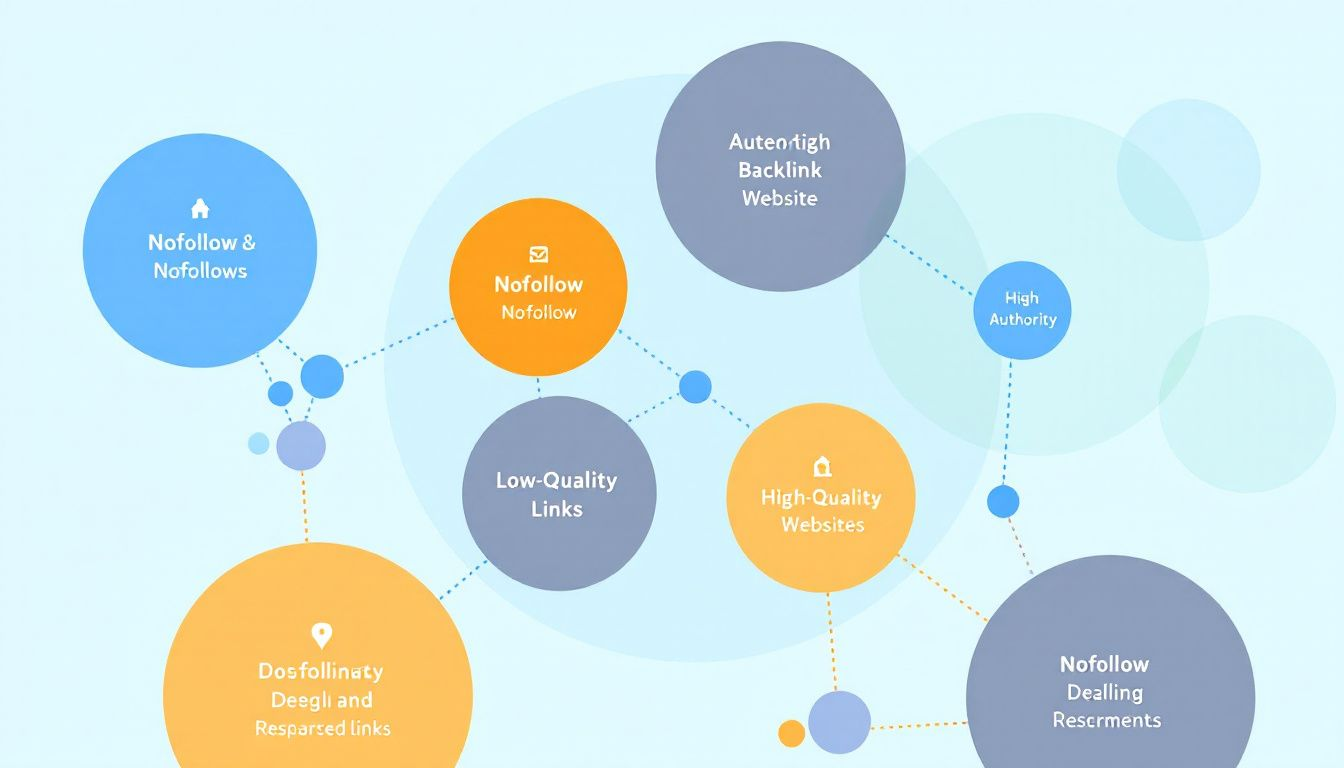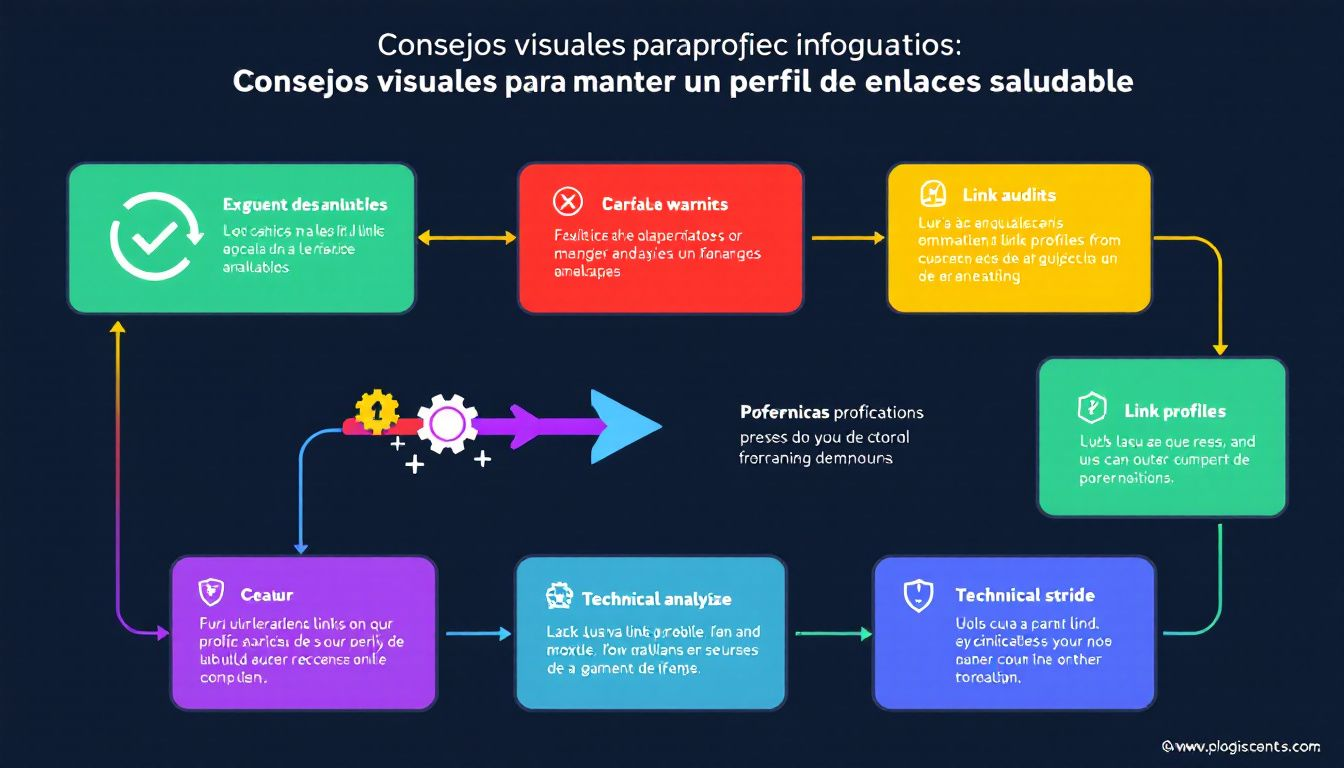¿Quieres mejorar tu posicionamiento SEO? Realizar una auditoría de backlinks es crucial. Este proceso te permite identificar enlaces tóxicos que podrían estar afectando tu sitio y potenciar aquellos que te benefician. Sigue leyendo para descubrir cómo hacerlo en cinco pasos sencillos.
Puntos Clave
- Una auditoría de backlinks evalúa la calidad de los enlaces que apuntan a un sitio web para identificar enlaces tóxicos que pueden afectar negativamente su posicionamiento SEO.
- Las herramientas como Semrush, Ahrefs y Google Search Console son esenciales para realizar una auditoría efectiva, permitiendo analizar y gestionar la calidad de los backlinks.
- La auditoría debe seguir un proceso que incluye extraer enlaces, comparar con competidores, clasificar enlaces tóxicos, y buscar nuevas oportunidades para crear enlaces de valor.
- Instalinko puede ayudarte a complementar tus auditorías de backlinks con servicios especializados, como la compra de enlaces de calidad que fortalecen la autoridad de tu sitio y mejoran su posicionamiento en los motores de búsqueda.
¿Qué es una auditoría de backlinks?

Una auditoría de backlinks es el proceso de evaluar todos los enlaces que apuntan a un sitio web, con el objetivo de identificar cuáles son beneficiosos y cuáles pueden estar causando daño. Un backlink, o enlace entrante, es un enlace desde otro sitio web que redirige al tuyo. Este tipo de backlink audit es esencial para determinar la calidad y relevancia de los backlinks, lo que a su vez impacta en el posicionamiento SEO del sitio.
El propósito de una auditoría de backlinks es identificar enlaces tóxicos que podrían estar perjudicando tu clasificación en los motores de búsqueda. Estos enlaces tóxicos pueden surgir de prácticas de SEO negativas o de sitios con baja autoridad.
Al detectar y resolver estos problemas, puedes mejorar considerablemente la salud de tu perfil de enlaces y, por ende, tu posicionamiento en los resultados de búsqueda.
Importancia de auditar los backlinks de tu sitio web
¿Por qué es tan crucial auditar regularmente los backlinks de tu sitio web? Los backlinks son esenciales para el descubrimiento de contenido, ya que ayudan a Google y otros motores de búsqueda a rastrear e indexar nuevas páginas. Sin una auditoría de enlaces periódica, es fácil perder el control sobre la calidad de los backlinks que apuntan a tu sitio.
Los enlaces de calidad son considerados como votos de confianza, mejorando la autoridad de tu sitio web en los motores de búsqueda. La calidad de estos backlinks influye directamente en cómo Google percibe tu sitio, afectando su posicionamiento. Al realizar una auditoría de backlinks, puedes comprender mejor la calidad y cantidad de enlaces que apuntan a tu sitio, lo que te permite ajustar tu estrategia de link building de manera efectiva.
Además, durante la auditoría, los enlaces se pueden clasificar en buenos, a eliminar y a desautorizar. El objetivo final es localizar oportunidades de enlaces de calidad y mejorar tu estrategia de link building para mantener un perfil de backlinks saludable y robusto.
Herramientas esenciales para realizar una auditoría de backlinks
Para llevar a cabo una auditoría de backlinks efectiva, necesitas las herramientas seo adecuadas. Algunas de las más recomendadas son Semrush, Ahrefs y Google Search Console.
Estas herramientas te permiten analizar y gestionar tus backlinks de manera eficiente, asegurando que tu perfil de enlaces se mantenga saludable y libre de enlaces tóxicos.
Semrush
Semrush es una herramienta poderosa que se utiliza para encontrar y analizar tus backlinks. Una de las características más útiles es la capacidad de evaluar la toxicidad de los enlaces. Un alto índice de toxicidad en los dominios referidos sugiere problemas en el SEO. Esto puede deberse a una estrategia de enlazado ineficaz, lo que impacta negativamente tu posicionamiento. Además, Semrush ofrece una puntuación de autoridad en un dominio, lo que indica su atractivo para atraer prospectos de link building.
La herramienta permite monitorizar y optimizar el perfil de backlinks, asegurando que se mantenga saludable y libre de enlaces tóxicos. Al utilizar Semrush, puedes identificar rápidamente qué enlaces están beneficiando tu sitio y cuáles podrían estar perjudicándolo, permitiéndote tomar acciones correctivas de inmediato.
Ahrefs
Ahrefs es otra herramienta fundamental para realizar una auditoría de backlinks. Ofrece análisis detallados del perfil de enlaces, lo que permite entender mejor la calidad y relevancia de los backlinks que apuntan a tu sitio. Con Ahrefs, puedes examinar numerosas métricas para evaluar los enlaces de un dominio, como la cantidad de dominios de referencia, el texto de anclaje, y la distribución de enlaces follow y nofollow.
La capacidad de Ahrefs para ofrecer análisis detallados hace que sea una herramienta indispensable para cualquier auditoría de backlinks. Te permite identificar rápidamente oportunidades de mejora y problemas que podrían estar afectando negativamente tu posicionamiento en los motores de búsqueda.
Google Search Console
Google Search Console es una herramienta gratuita proporcionada por Google que permite extraer todos los enlaces que apuntan a tu sitio web. A través de su sección dedicada a enlaces, puedes ver todas las referencias a tu sitio y descargar esta información en un formato accesible para su análisis.
Además, Google Search Console ofrece la herramienta Google Disavow, que se utiliza para desautorizar enlaces nocivos. Esta función es especialmente útil cuando no puedes contactar al propietario del enlace perjudicial, permitiéndote limpiar tu perfil de enlaces de manera efectiva.
Pasos para realizar una auditoría de backlinks efectiva
Realizar una auditoría de backlinks efectiva implica varios pasos clave:
- Extraer todos los enlaces que apuntan a tu sitio web.
- Comparar tu perfil de backlinks con el de tus competidores.
- Eliminar o desautorización de enlaces perjudiciales.
Estos pasos son fundamentales para mantener la salud de tu perfil de enlaces y mejorar tu posicionamiento en los motores de búsqueda.
A continuación, desglosamos cada uno de estos pasos para guiarte en el proceso.
Paso 1: Extrae todos los enlaces de tu sitio web
El primer paso en una auditoría de backlinks consiste en extraer todos los enlaces que dirigen a tu sitio web. Este proceso es fundamental para comenzar la evaluación de la calidad de esos enlaces. Google Search Console es una herramienta excelente para esto. A través de su sección dedicada a enlaces, puedes ver todas las referencias a tu sitio y seleccionar la opción de descarga para obtener todos los enlaces en un formato accesible.
Esta extracción inicial te proporciona una visión completa de tu perfil de enlaces, permitiéndote identificar rápidamente cualquier enlace sospechoso o tóxico que pueda estar afectando tu SEO.
Paso 2: Analiza tu perfil de backlinks frente a tus competidores
Una vez que hayas extraído todos tus enlaces, el siguiente paso es comparar tu perfil de backlinks con el de tus competidores. Utilizando herramientas como Ahrefs, puedes teclear tu dominio y el de entre 1 y 4 competidores en la sección de análisis de backlinks. Esto te permitirá identificar brechas y oportunidades de mejora en tu estrategia de link building.
Comparar tu perfil de backlinks con el de la competencia es fundamental para entender dónde te encuentras y qué puedes hacer para mejorar. Encontrar y evaluar problemas principales puede evitar que la competencia te supere.
Paso 3: Clasifica y agrupa los enlaces tóxicos
El tercer paso es clasificar y agrupar los enlaces tóxicos. Separar los enlaces beneficiosos de los perjudiciales es crucial para mantener un perfil de enlaces saludable. Utilizando herramientas SEO, puedes agrupar los enlaces según su nivel de toxicidad.
Los enlaces con una puntuación de toxicidad menor a 45 no se consideran graves y generalmente no requieren acción inmediata. Un alto índice de toxicidad de los dominios referidos puede ser resultado de una estrategia de enlazado pobre o de SEO negativo.
Interpretar la clasificación de enlaces correctamente es clave para evitar penalizaciones de Google.
Paso 4: Elimina o desautoriza los enlaces perjudiciales
Antes de utilizar un navegador, es importante asegurarse de que la página esté actualizada para garantizar la mejor experiencia de navegación.
Una vez que hayas clasificado y agrupado los enlaces tóxicos, el siguiente paso es eliminarlos o desautorizarlos. Es preferible desautorizarlos en Google Search Console si no puedes contactar al propietario del enlace perjudicial. La eliminación o desautorización de los backlinks más tóxicos es esencial para limpiar tu perfil de enlaces.
Texto con el keyword incorporado:
Después de finalizar el proyecto, se evaluaron los resultados y se realizaron ajustes necesarios.
Una vez que hayas clasificado y agrupado los enlaces tóxicos, el siguiente paso es:
- Eliminarlos o desautorizarlos.
- Desautorizarlos en Google Search Console si no puedes contactar al propietario del enlace perjudicial.
- Limpiar tu perfil de enlaces eliminando o desautorizando los backlinks más tóxicos.
Al contactar a los webmasters para eliminar enlaces tóxicos, asegúrate de enviar un mensaje natural y demostrar que no eres un spambot. Si no puedes contactar al propietario, utiliza la herramienta de desautorización de Google para limpiar tu perfil en sitios web.
Documenta todos los pasos dados para remover enlaces malos antes de enviar la lista a Google.
Paso 5: Encuentra nuevas oportunidades para crear enlaces de valor
El último paso es buscar nuevas oportunidades para crear enlaces valiosos. Identificar nuevas oportunidades puede incluir colaboraciones con bloggers, participación en comunidades online y la creación de contenido de alta calidad que atraiga enlaces naturales.
Buscar nuevas oportunidades de enlaces es un proceso continuo que requiere atención y dedicación. Implementar una estrategia de link building eficaz fortalecerá tu perfil de enlaces y mejorará tu posicionamiento en los motores de búsqueda.
Consejos para mantener un perfil de enlaces saludable

Mantener un perfil de enlaces saludable es un esfuerzo constante. Realizar auditorías periódicas te permite resolver problemas menores antes de que se conviertan en dificultades mayores. Analizar los backlinks de manera periódica es beneficioso y compensa el esfuerzo.
La variedad en los dominios de referencia es clave para un perfil de enlaces robusto. Además, es esencial mantener un equilibrio entre enlaces follow y nofollow, y utilizar textos de anclaje diversos y relevantes para mejorar la efectividad de tu perfil de enlaces.
Resumen
En resumen, una auditoría de backlinks es esencial para mantener y mejorar la clasificación de su sitio web, y desempeña un papel vital en su estrategia offpage SEO fuera de la página. Desde la extracción de enlaces hasta la eliminación de los tóxicos y la búsqueda de nuevas oportunidades, cada paso es crucial para garantizar un perfil de enlaces saludable.
Realizar auditorías regularmente no solo protege tu sitio de penalizaciones, sino que también te ofrece valiosas oportunidades para mejorar tu estrategia de link building. No subestimes el poder de una auditoría de backlinks bien ejecutada.
Preguntas frecuentes
¿Qué es una auditoría de backlinks?
Una auditoría de backlinks es la evaluación de los enlaces que dirigen a un sitio web, crucial para identificar aquellos que son beneficiosos y los que pueden perjudicar su rendimiento. Este análisis ayuda a mejorar la estrategia de SEO y la reputación en línea.
¿Por qué es importante auditar los backlinks?
Es importante auditar los backlinks porque ayuda a mantener la autoridad de tu sitio web y a mejorar su posicionamiento en los motores de búsqueda. Esto permite identificar enlaces tóxicos y oportunidades de mejora para tu estrategia SEO.
¿Qué herramientas puedo usar para una auditoría de backlinks?
Para una auditoría de backlinks, puedes utilizar herramientas como Semrush, Ahrefs y Google Search Console, que son fundamentales para obtener análisis detallados y efectivos.
¿Cómo puedo eliminar enlaces tóxicos?
Para eliminar enlaces tóxicos, contacta a los webmasters de los sitios correspondientes o utiliza la herramienta de desautorización en Google Search Console. Esto te ayudará a proteger la salud de tu perfil de enlaces.
¿Con qué frecuencia debo auditar mis backlinks?
Es recomendable auditar tus backlinks de manera regular, al menos cada 3 a 6 meses, para asegurar un perfil de enlaces saludable. Esto ayudará a identificar enlaces tóxicos y mejorar tu estrategia de SEO.

